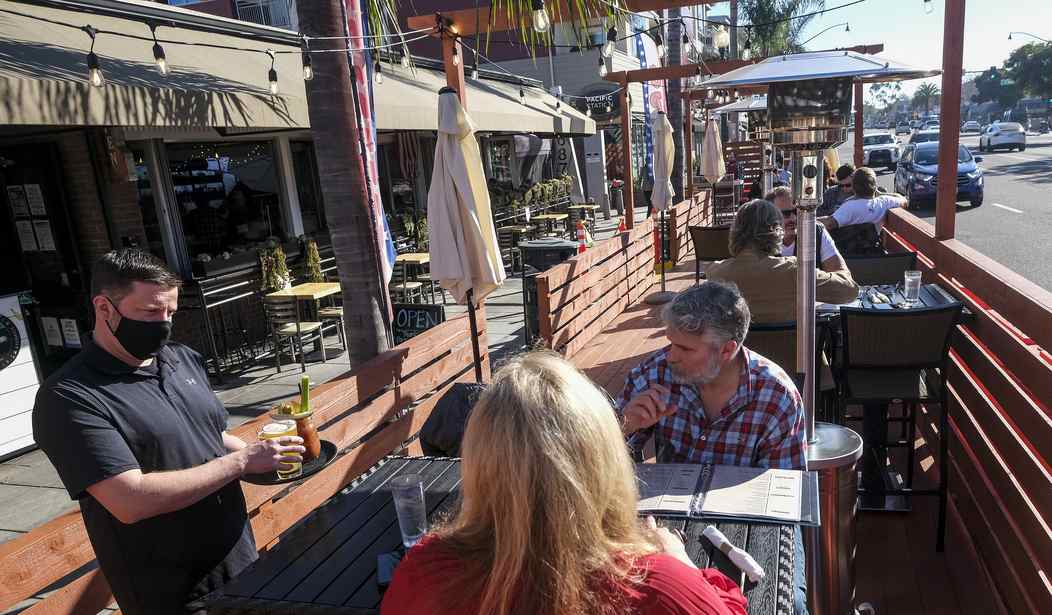Although the fact that some cities are seeing more reservations now than they were in April 2019 raises a question: How? Didn’t many thousands of restaurants go bust during the pandemic?
Where’s the extra capacity coming from?
Restaurant reservations, including diners who placed themselves on a waiting list, were up 46 percent in April compared with April 2019, according to the review site Yelp (and up 23,000 percent compared with April 2020 when most Americans began staying at home during the pandemic). Yelp’s competitor OpenTable paints a similarly rosy picture…
Restaurant traffic in Oklahoma, Nevada, Rhode Island, Florida, Connecticut, Texas, Maine and Indiana has completely recovered from the pandemic, OpenTable data shows. In many states, the pre-pandemic size of the restaurant industry doesn’t seem to be a limiting factor: They’re blowing right past “recovered” levels and into “growing,” with little indication of slowing. Five cities in Florida and three in Texas are well above their traffic before the pandemic, while other cities, including Seattle, San Francisco and Portland, Ore., languish…
Many restaurants that were listed as defunct have crept back out of hibernation this spring, according to Hudson Riehle, senior vice president for research at the National Restaurant Association. The association’s April 2021 survey shows some 90,000 restaurants have closed permanently, down from a 2020 estimate that 110,000 restaurants would close for the long term.
Note the detail about San Fran, Seattle, and Portland. The restaurant boom isn’t happening everywhere — yet. But it’s certainly happening in some places:

What’s the difference between the cities in the graph and the cities I just mentioned? Red states and blue states (mostly). The west-coast states are deep blue and liberals tend to be much more cautious about reopening and socializing. Whereas Texas and Florida especially have been open for months, with residents having already had time to gradually re-acclimate to normalcy. Vegas is technically an outlier in that it’s located in a blue state, but Vegas is Vegas. People go there to indulge. Of course its restaurant scene is booming.
Like I say, though, where’s all this extra capacity coming from? It could be that so many people are clamoring to dine out after 14 months indoors that many restaurants are now at capacity every night when, perhaps, pre-pandemic they were only at three-quarters or two-thirds capacity. The fact that many restaurants added outdoor dining during the pandemic also may mean that they now have more seating capacity on average than they did before. And more restaurants are coming online after having been put in dry dock for the past year, with the U.S. reaching a milestone this past week:

That’s the first time since March 2020, I assume, that as many as 80 percent of American dining establishments have been taking reservations.
As the news about the pandemic grows brighter in every respect, we should expect more people to feel safer going back out to eat. The latest encouraging data comes from a group that won’t be going out to restaurants themselves but whose newfound safety from COVID should give confidence to those who will.
The study looked at residents of nursing homes that had received at least one dose as of Feb. 15 and anyone at the facilities present on the first day of their vaccination clinic who had not yet been vaccinated as of March 31.
After receiving a first dose, 4.5 percent of residents still contracted the virus, although most cases were asymptomatic, researchers wrote. Of those receiving the second dose, only 0.3 percent got the virus after 14 days.
The benefit carried over to those in the same nursing homes who did not get vaccinated. Their rate of infection dropped to 0.3 percent from 4.3 percent. For all groups, most infections were asymptomatic; and the rate of both symptomatic and asymptomatic infections decreased over time.
When so many people in a given community are immune that even the unvaccinated have little to fear because the virus can no longer travel, that’s herd immunity in action. Nearly 85 percent of American senior citizens have received at least one vaccine dose, and of course nursing-home residents were given priority last December because of the special mortality risks they face. They didn’t need to visit a pharmacy or a vaccination center either; the doses were brought to them. As a result, they must be among the most thoroughly immunized groups in the entire country. And it’s paying off for everyone in that group, including those who declined the shots.
Exit question, just because I’ve been wondering about it: How did it come to pass that America’s most populous state also seems to be the one closest to herd immunity? California is tied for the lowest positivity rate in the country (1.1 percent) and the lowest rate of cases per 100,000 people (3.4). Their vaccination rate is solid but not top 10, with 54 percent of Californians having received their first dose. You would think that a state with a lot of people would see a longer pandemic simply because there are more places for the virus to travel, yet Cali looks like it may be the first one out. How? It could be that their early and protracted lockdowns successfully limited transmission. It could be that the state’s very liberal population has been and remains cautious about socializing even absent restrictions. It could be that the nice weather is keeping people outdoors. Or it could be that, despite its size, the state has an unusually high degree of natural immunity from the ferocious outbreak it endured this past winter. (One estimate in March was that roughly *half* of L.A. County’s 10 million residents had antibodies for COVID.) What’s the answer? All of the above?








